Welcome to the week. It’s going to be a great! Let’s get started.
Here are the most notable items our community came across in the past seven days:
Cougar attack: Friends riding bikes together on a trail near Fall City, Washington heroically fought off a cougar that attacked a 60-year old woman. Cyclists used their bike to pin down the cougar until wildlife officials arrived. (KOMO)
Less pavement, more life: Portland’s very own Depave leads this article that profiles the growing worldwide trend of removing pavement and replacing it with plants in a bid to improve lives and battle climate change. (BBC)
Silly Americans: Was fun to see headlines about how a massive Taylor Swift concert in Melbourne, Australia could be held at a stadium without acres of car parking lots next to it. Turns out, public transit is a thing. (Independent)
Consequences, finally: An intoxicated woman who was driving 81 mph on a 45 mph roadway in Los Angeles and hit and killed two young boys was found guilty of murder and will face 34 years to life in prison. (The Guardian)
Dubliners want fewer cars: Ireland’s largest city will enact a bold plan to significantly reduce driving in its city center and many of its residents support the plan. (Bloomberg)
TriMet traffic toll: Left turning buses, homeless Portlanders, and careless bus operators are among the reasons why our local transit agency experienced it’s deadliest year in almost a decade in 2023. (The Oregonian)
London’s success: I think the rise of cycling in London and how that makes it a larger target for politicians and public opinion helps explain part of the bikelash Portland faced in the mid-late aughts. (Bloomberg)
Bike vacations for the 1%: If you’ve got a lot of cash and want to ride and hang out with professional cycling stars, there’s a tour company that can make your dreams come true. (Robb Report)
Video of the Week: Banning drivers from streets in front of schools should be a top priority for every city. Watch this Streetfilms from Paris and you’ll see why:
Thanks to everyone who sent in links this week. The Monday Roundup is a community effort, so please feel free to send us any great stories you come across.



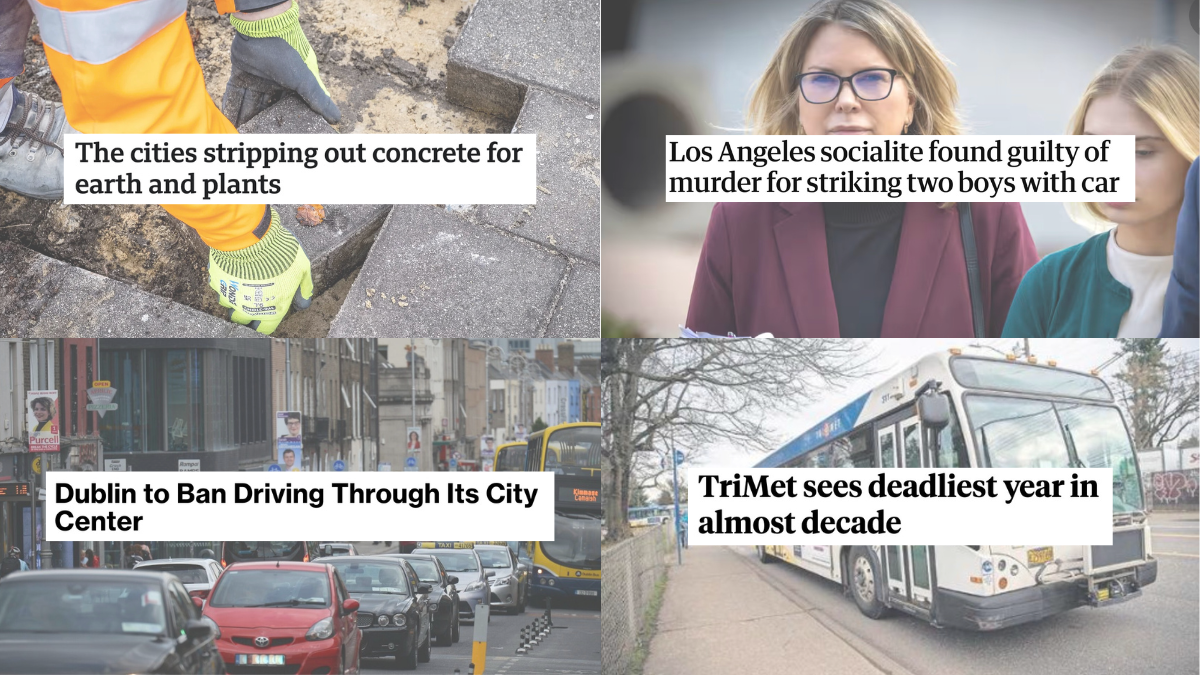
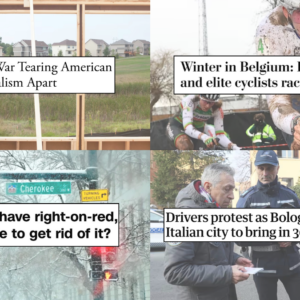
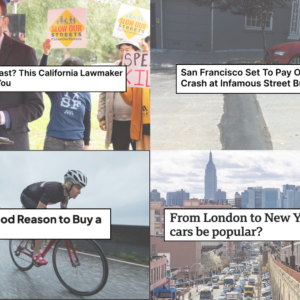
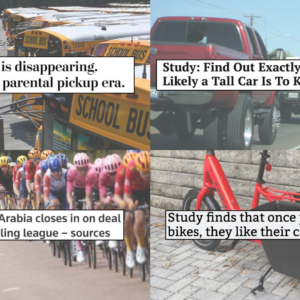
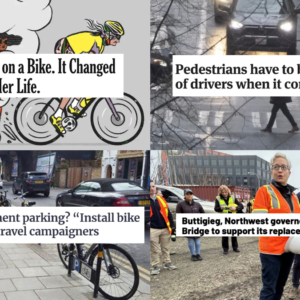
Thanks for reading.
BikePortland has served this community with independent community journalism since 2005. We rely on subscriptions from readers like you to survive. Your financial support is vital in keeping this valuable resource alive and well.
Please subscribe today to strengthen and expand our work.
The “TriMet traffic toll” article link is broken for me, takes me to a login page
That’s The Oregonian for you. If an article is interesting or relevant to Portlanders, they stash it behind a paywall.
Luckily BikePortland has enough subscribers that we can make the posts freely available to non-subscribers. But hey, has anyone noticed Jonathan’s bold new banner ads asking for subscriptions?
Ride on sister there anywhere you wish to go. Joni Mitchel is there where you go.
https://addons.mozilla.org/en-US/firefox/addon/bypass-paywalls-clean-d/
https://gitlab.com/magnolia1234/bypass-paywalls-chrome-clean
In 2023, TriMet vehicles killed 5 people. Private vehicles (unclear if this includes trucks) travel about 400x more miles than TriMet does per year.
That means it’s markedly safer to share the street with a random car than a TriMet bus.
The average person in the Portland–Vancouver area drives about 17 miles per day (down from about 20 miles per day in the year 2000). The average TriMet bus drives hundreds of miles per day. Yet about 10 times more people were killed in traffic collisions with cars last year compared to buses. You do the math.
I did. 10x more deaths (actually more like 20x) while traveling 400x more miles.
What’s your source for the claim that private vehicles travel 400 times farther than TriMet buses and trains per year?
Metro for autos and TriMet for buses. The TriMet data is easy to find, the Metro number was in a recent report that I did not save the link to.
But it seems about right intuitively.
I wasn’t able to find those data. Are we including all miles driven, or only miles driven in service? There are also confounding factors: Buses operate mainly on major streets that are already more dangerous for pedestrians. They are found more in low-income neighborhoods, where people are more likely to travel on foot. And the nature of public transportation itself brings buses and pedestrians together in the same area, increasing the potential for conflict.
On one hand, it’s a trivial observation to say larger vehicles pose greater dangers to pedestrians. But we can’t infer anything about a “random bus” from raw numbers stripped of all context.
Trimet: 26,423,760 miles per year
Vehicles : 29,842,263 miles per day
29,842,263 * 365 / 26,423,760 ~= 412
No matter how you cut it, last year TriMet killed a lot more people per mile than private vehicles did.
Other interesting stats from the TriMet data… It costs TriMet a bit over $10 per passenger boarding (more on bus, less on Max).
And each ride on WES is subsidized by a staggering $88.53, which is 99.3% of the cost of providing someone with a ride. By point of comparison, it would cost $35 for me to take an uber from one end of the WES line to the other. We’d save a lot of money if we closed WES and handed out Uber vouchers, or just ran a van service or something.
https://trimet.org/about/pdf/trimetridership.pdf
https://www.oregonmetro.gov/sites/default/files/2024/02/13/20240108_transportation_system_monitoring_daily_vehicle_miles_traveled_1990-2022.pdf
We’d save a lot of money…if we ignored all the external costs that aren’t accounted for in the price of a single ride-hailing ride, that is.
$90 per passenger would cover a lot of external costs. You’d also need to factor in the external costs of running and maintaining a lightly used heavy rail system, which are certainly significant.
Heck, run a fleet of vans or a bus and save even more, and maybe even save some folks a drive to the station. The point is the economics of this service are nuts.
In other words, we could spend the same amount of money and end up with more pollution, more traffic congestion, more wear and tear on roads, and more car crashes. Now why didn’t I think of that?
Once you factor in the pollution of the train, I’ll bet your pollute less by driving, probably a lot less, especially if you arranged service as a flexible van pool.
If we instead spent the money to improve transit service elsewhere, it could be a total win.
Think of it this way… We have a pot of money to spend on transit. Is WES the most effective way to spend it? Or would we get a bigger payoff using it differently?
You seem wedded to the idea that what we’re doing now is the best thing, something I’m often (falsely) accused of.
What’s more, you’re inferring a relationship based on a sample size of exactly two individuals (the other three victims were killed in collisions with MAX trains). The previous two years saw zero fatal collisions with TriMet buses (I didn’t look any further back than that). That’s a statistical blip, not a trend.
I think this is one of those high school physics test questions…Trimet buses being larger with a higher mass vehicle will always protect its occupants and operator vs what it hits (motorcycles, mopedistas, bakfieters, SUVs etc.)…;-)
And at least a few of these deaths were suicides.
“Many people took the opportunity to inform Americans that Melbourne Cricket Ground is accessible via the Jolimont and Richmond train stations, as well as several tram stops.”
I’m sorry, there’s just no way a stadium holding more than 100,000 people can be adequately served by fixed-route transit, which I have been informed is an obsolete technology that simply doesn’t work with the political and economic realities of the 21st century. Am I missing something here?
Interestingly, it seems that parking was specifically banned at that stadium in 2018 to prevent vehicle attacks on pedestrians. Cars are a scourge on society no matter how you look at it.
Melbourne is a transit mecca.
By comparison, Portland had (in 2011, more specific data not easy to find, at least it’s pre-covid) an all-trips transit mode share of 4.4%, so it’s clear that, to the extent Melbourne is comparable, if we spend enough money and build a big enough network, we too can hope to get up to 8% of trips by transit.
Let’s get to work!
https://en.wikipedia.org/wiki/Transport_in_Melbourne
https://www.oregonmetro.gov/sites/default/files/2020/05/03/2018-RTP-Ch4_Our-growing-changing-region.pdf
(From Wikipedia and looking at Google Streetview)
The old stadium has been redeveloped several times and added to between 1854 and 2020, and apparently has adequate built-in parking ramps and spaces within the structure for 100,000 attendees, and parking used to cost $10 per show, enough spaces apparently for even the nearby sports venues in the extensive complex. Aside from traffic driving the wrong way as they do throughout Australia, the stadium is very similar to any in major US cities (aside from the extra long construction process), they even do “tailgating” there. Billy Graham performed a miracle and got 143,750 attendees inside way back in 1959, but capacity was later reduced for safety reasons. The transit was added in various phases beginning in 1863.
Yes, it looks similar, except for the “asphalt desert” of parking that would be sitting empty 99% of the time, which seems to have been the point of the article.
In fact they took out the surface parking and put in a nice huge park around the stadium, but they still have the internal stadium parking for 100,000, it’s just not in use right now and accessible except for VIPs.
The park (named Yarra Park) actually predates the modern stadium, going back to 1856. Seems doubtful that a venue seating 100,000 would have room for that many cars inside it as well. The interior would have to be literally nothing but parking, plus a 30-story subterranean garage underneath it all. Remember that a single parking space is about 150 sq. ft. Multiply by that by 100K and you would need almost 350 acres just for parking.
Dublin is banning through traffic in its downtown core. How much through traffic does Portland have? I’m going to guess not much, as driving there is so slow and connectivity isn’t particularly good.
So to my friends in Dublin, I say “Welcome to the club!”
(And I’ll note than when 80% of the people support restricting car use, restrictions are much easier to enact than when 8% (or .8%) do. If we can get more folks on board, anything* is possible!)
*Or at least some things — we’ll probably never have good transit blanketing SW Portland.
As long as politicians are controlled by the downtown business association/lobby/whatever we’ll likely never get rid of cars in downtown Portland.
Heck, it’d be nice to have a “Car-Free-Wednesday” downtown and see what happens. Do more people come downtown anyway without their cars, or does it become a desert void of anyone in the paranoid minds of the rich property/business owners?
What would you do when someone who didn’t get the memo tries to drive into downtown for a Wednesday morning meeting?
Trying to imagine American parents rallying to protect our schools from motorized traffic — when the parents are among the worst of the dangerous drivers. One of the most dangerous parts of my bike commute involves passing Sunnyside Environmental K-8 school during morning drop off. Double-parking, stopping without signaling, pulling into traffic without signaling, opening doors into traffic, keeping engines running, etc. Current work schedule allows me to avoid it, but in the past I have muttered “Lo, I pass through the Valley of Death” every time I had to negotiate it.
In my community of Greensboro NC (pop 300,000) everyone who has a higher income (of any race) sends their kids to private schools all over town, but mostly in the traditionally white areas of the city upwind of where all the smelly factories used to be (closed long ago) and yes, the car traffic at each of those schools is so bad that off-duty police are hired to direct parents dropping off or picking up their kids. Meanwhile, public schools even in the rich white parts of town have their kids bused in on county yellow school buses (school districts are run by counties in NC), since none of the local kids will ever have an opportunity to bike or walk to school as their parents are too rich and paranoid to send their kids to the local school – and only a handful of parents (or unrelated guardians) drop off their kids. In every single public school here, a majority of kids receive free or reduced-priced cafeteria lunches (and quite a few free breakfasts too).
Our local bike advocacy groups have been trying for years to get the city and county to put in sidewalks and bike lanes to local schools to encourage parents to send their kids safely to their local school, to no avail. The city and county regularly take note that the bike advocates themselves are childless and almost universally white and thus are utterly clueless on why local parents don’t allow their kids to bike or walk to school – if the parents are rich (and usually white or Asian), they simply don’t ever enroll their kids in the local school – they are sent to private schools instead where they have a much better chance at learning to read and write. And if the parents are poor, they are very highly likely to be black or Hispanic and know that their kids will be attacked by gangs along the way (every neighborhood has at least one major gang in control of their “territory” which the police are very aware of, and most white residents are totally clueless about).
We do have Safe Routes 2 School programs here in NC, but they are chiefly aimed at getting parents to drive safely to and from the schools, to install child seats, and so on. A majority of local kids here of all races never learn to bicycle – poor kids because there’s no where to bike safely without getting attacked by gangs – and rich kids because where they live there are no sidewalks and the stroads are barely wide enough for two cars. However, the city and some schools do have periodic “bicycle rodeos” and there are some “learn to ride” programs at community centers.
Yep. Some of the most dangerous traffic field work I had to with the City of Vancouver was responding to traffic safety complaints from residents along school zones by parents running late picking up / dropping off offspring. Give me a freight corridor any day. 😉
Depaving: The biggest threat to the adoption of paver style pervious surfacing in the US is the lack of follow up maintenance performed by street sections of public works agencies, especially tasks that are not mechanized. These types of streets need annual sand replenishment which requires a broom + sand + human power (like what is more typical of European public works departments). When I was at Vancouver, we ripped up our downtown intersection (6th Street) of sand set pavers (2000). And in Honolulu, I am seeing the same “progress” for their new parking lot streets with pavers.
Every time I would visit Europe, in nearly every city work crews were digging up sections of streets for repairs – they would remove and pile up the pavers, then the curbs, then dig into the sand underneath to get to water lines, electrical conduits, sewers, and so on, then put everything back a few days later. It reminded me of Lego.
Yep. That is the beauty of pavers and sand versus concrete and cutters. The only thing better are utility runs with removable covers.
Here was the view out my apartment window in Paris. I watched the men carefully lift up the pavers for extensive utility work, and then replace them weeks later. Their hammers make a soothing tap, tap sound. Those bags are full of pavers, which are saved and reused.
Sous les pavés, la plage
Beautiful image Lisa! I’ve got a whole collection of urban street construction projects in Europe, including wine glasses on top of pavers.
Portland cyclist killed Sunday morning https://www.koin.com/news/crashes/cyclist-dead-driver-detained-by-community-members-after-se-portland-crash-ppb
Thanks Jay. I typically don’t put local headlines in the MRU…especially if I know I’ll deal with the story on my own. Speaking of which, I just posted something on that https://bikeportland.org/2024/02/26/driver-kills-man-on-a-bicycle-at-southeast-portland-homeless-camp-384234
London Bike Boom: This reminds me of the Portland I moved to in 1997, when the mode split was over 5% (eventually rising to 7.2% before dropping to its current still-impressive 3%).
I’m a person who suffers from type 2 diabetes – it’s a condition not a disease – like a broken leg it can be fully recovered from, that roughly 9 to 10% of Americans have to deal with it. My pancreas (a small gland opposite of the heart on my right chest cavity) isn’t regulating my blood sugars quite as well as it should and it seems that it went haywire when I was really sick with Covid 2 years ago (Beta followed by Omicron apparently), or rather, the unfortunate way I was fighting the virus (like with flu I was drinking too much juice and not eating enough protein.) Anyway, I wound up in the hospital for a week in intensive care, which in fact was kinda fun but very expensive. Afterwards I’ve been put on various drugs, a new diet, and prescribed lots of exercise (I was on my bike within a week.) And just like most people with new awful conditions, as well as cities going through similar trauma, I wanted a magic cure, a silver bullet, the one drug to fix everything.
But that magic pill doesn’t exist; nor does that easy way to get to be bike-friendly like Amsterdam with a 49% mode split.
And so I have to take a bunch of pills I’d rather not take (I’m “lucky” in that it only costs me $0.75 per day for pills), test my blood sugars at least 3 times per day (I poke my skin then use these very clever plastic sticks to take a reading – it’s really amazing, whoever invented it ought to get a Nobel Prize), exercise daily, watch my calories, cut down majorly on carbs (I haven’t eaten pastries or spaghetti in over a year), and increase my protein, veggies, and nuts. It’s a lot of work, vary unfun.
When Portland had that super duper 7.2% mode split, clearly on its way to a projected 25% mode split – who could doubt it? – and soon every city in the USA thought that if they imitated Portland they too could get to a 25% mode split. With a few years most cities got a Bronze “Bicycle Friendly Community” designation from the League of American Cyclists (any city or university that published any sort of bicycle master plan no matter how flimsy or false got the designation.) And soon local newspapers were boasting about the new designation and so on. But the numbers in most communities stayed at a measly 0.2% or less mode split. So communities started hiring “bike/ped coordinators”, but being cheap, the new hirees were consistently poorly paid, treated like crap by their engineer bosses, and if they had any talent at all, they moved elsewhere ASAP. However, some progress was made, new facilities put in, cities got grants to do more, and a few people even went on junkets overseas to study how other places did it, sort of.
Meanwhile, Portland, America’s bike capitol, started to see a drop in mode split, sometimes an alarming drop in the every-5-years American Community Surveys, even before the pandemic accelerated the process. The problem was, we still don’t know what really caused the initial rise, nor do we have a “silver bullet” on how to cause it a rise to happen elsewhere – some cities succeeded where others failed with exactly the same processes – in much the same way as those with diabetes go through the same ups and downs with our quarterly A1C blood tests, to see how we are recovering (or not).
And so London is up. Will it be up further 5 years from now? Or will it plunge? Or will London be in a Portland limbo of a gradual tea-time of statistical insignificance?